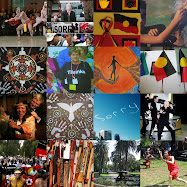 Above: Sculpture in Loftus St, Sydney called The Bonds of Friendship. It commemorates the sister city relationship between Sydney and Portsmouth, England (for more about the sculpture and its significance - see the text at then end of this post*).
Above: Sculpture in Loftus St, Sydney called The Bonds of Friendship. It commemorates the sister city relationship between Sydney and Portsmouth, England (for more about the sculpture and its significance - see the text at then end of this post*). This relationship goes to the very origins of Australia as a nation; the First Fleet bringing the first convicts to what was then known as New South Wales, left Portsmouth on 13th May, 1787, arriving at Sydney Cove on 26 January 1788. There is an identical sculpture at Sally Port (!!), Portsmouth, England:

Another link between Sydney and Portsmouth is that the first version of the naval cruiser,
the Sydney, was commissioned in Portsmouth (not the more famous one sunk during World War 2). The first Sydney served during WW1 and was broken up on Cockatoo Island in Sydney Harbour in 1928.
Sydney has six sister cities (or does it?), and a sister port (which I've blogged before -
see here).
The cities are
San Francisco, Wellington, Nagoya, Florence, Portsmouth and
Guangzhou. The port is Yokkaichi Port Authority, Japan. But, is there controversy? Is Wellington a sister city or not?
Sydney City Council claims it is, but
Wellington City Council has other ideas, relegating Sydney to the status of "Friendly City", saying "A friendly city relationship is less formal than a sister city relationship and it generally has a lower profile. It is likely to be a long term relationship, but the level of community support and involvement is not as high as with a full sister city relationship." So there, Sydney!
I've posted additional pics relevant to these cities on Sydney Daily Photo Extras.
Ann at Sydney Meanderings and Julie at Sydney Eye are also posting today, so we've divided the spoils. Julie is concentrating on Nagoya, and Ann has gone for Florence and San Francisco. That's why I'm bringing you Portsmouth (and some old pics of mine of Wellington and Guangzhou).
Below: Admiral Nelson's ship The Victory at Portsmouth (taken May 2003). We don't have a replica of that.

To see Sister Cities from all around the world click here to view thumbnails for all participants
Below: Pearl River, Guangzhou, May 1978. The river is now lined with skyscrapers.
 Below: View of Wellington, New Zealand October 1984
Below: View of Wellington, New Zealand October 1984
 * Sculpture - The Bonds of Friendship by John Robinson - further details.
* Sculpture - The Bonds of Friendship by John Robinson - further details.
The sculpture used to be located outside Customs House, closer to Sydney Cove where the First Fleet arrived. It has been moved about 250 metres inland, after disappearing altogether for a time around 2001.
The plaque in front of it says:
" This memorial commemorates the voyage and arrival in Sydney of the First Fleet which brought to Australia its forst European settlers under the command of Captain Arthur Phillip R.N. The fleet sailed from Portsmouth on 13 May 1787 and anchored in Sydney Cove at a spot just north of this memorial on 26th January 1788.
The fleet comprised eleven ships: H.M.S. Sirius Flagship, H.M.S Supply and armed tender, six transports Alexander, Lady Penrhyn, Charlotte, Scarborough, Friendship and the Prince of Wales, together with three store ships Fishburn, Golden Grove and Borrowdale. At departure they carried a total complement of about 1487 who embarked at Plymouth, Portsmouth and The Thames.
The plinth of the memorial was donated by the Fellowship of First Fleeters, all of whom are direct descendants of those who arrived with the First Fleet. The granite block above the plinth was quarried at Dartmoor, England and donated to the City of Sydney by the City of Portsmouth as a return gift for a similar block of granite from NSW given to them by this city. It was set in place by the Lord Mayor of Sydney on the 2nd July, 1980.
The sculpture Bonds of Friendship was presented by the Bank of N.S.W. It is a companion piece to one erected by the Lord Mayor's Australian Settlers Commemoration Committee of Portsmouth and which is located near the Sally Port at Portsmouth Harbour through which Captain Phillip and many of his fellow voyagers passed on their way to embark.
The Bonds of Friendship symbolises the closeness of the ties that were forged between Portsmouth and Sydney as a result of the voyage of the First Fleet and represents links in a chain joining both cities. It was designed by John Robinson. The donor, the Bank of New South Wales wa sthe first bank and the first corporation established in Australia."
Unveiled 17 September 1980.
 At Central Station there is a nice little display of railway heritage in the beatifully restored old ticket office.
At Central Station there is a nice little display of railway heritage in the beatifully restored old ticket office.























































